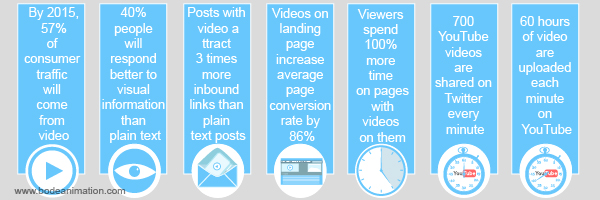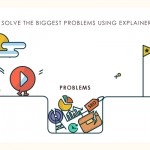
Dual coding theory is a theory of cognition according to which humans process and represent verbal and non-verbal information in separate related system. For example, the word “circle” can prompt one to visualize a circle and also if we see the image of a circle can bring to mind the word “circle.”
Visuals are great and add a ton to helping people retain what they are watching. According to the brain science, all our brains filled up with visuals rather than tight script and strong messages.
In fact studies shows that if you only stimulate the auditory sense people will retain just 10% of what they hear. Stimulating both the auditory and visual sense results with a retention rate of 58%.
Is dual-coding theory helpful for business?
The answer is always “Yes”, since every business is trying to grab their customer’s attention to deliver their brand message.
When most of the targeted audience’s time spent on a website is less than 2 minutes, it is necessary to explain your product or service in short time in an effective way.
The way you explain may be of problem solving, briefing the concept and even via a good story. But the entire ultimate goal is to make your customers and prospects to understand “what is all about your business”, which then creates a chance that they will be using your product and become your paying customers.
Audiovisual contents are more effective on the followings than textual contents,
Shows your brand without telling people about them
Easily sharable
Enhances your brand
Supports search optimization
Helps in building audience
Eliminates language barriers
Social media friendly
How auditory and visual senses stimulated by an explainer video:
Its no wonder that we are moving towards the video marketing world! Video allow us to use both auditory and visual components.
Researchers found that the uptake of information was highest for audiovisual correspondence. Imagine, you are watching a television commercial with your eyes closed or without sound, then it’s obvious to be less effective. Of course, there is some exception to every rule.
But in case of marketing campaigns and branding initiatives, majority of companies are more successful when they include verbal, visual, and auditory elements. And many business people realized that, campaigns which tap into multiple senses are more effective than those that focus on only one sense.
A boring text alone never satisfy your audience, when their eyes are hungry for the visuals and a great image won’t generate the same results that a great image with a specific, verbal message can deliver.
Let’s remember some fascinating statistics on videos,

Short and well-produced explainer videos are the most effective and efficient way to convey the brand message in an entertaining way. Which provides the space for covering both the auditory and visuals to achieve the best marketing results.
In an explainer video, script in words (Audio) conveys complex business ideas as a simple message, and usage of images (Video) to communicate your text message.
A business presentation with a simple explainer video is more successful than a presentation with plain texts and static images.
With the advantages of dual-coding theory, explainer video provides great learning experience and leaves memorable impact on your brand.
With the above,
We can conclude that explainer video has the power of stimulating both auditory and visual senses. Therefore, most of the business people strongly believe that an explainer video is a more effective way to communicate the audience to explain the core message.
Thus, the effect of visual and auditory cues to the videos’ responses automatically turns into increased ROI, better Google result and high rates of conversions.

